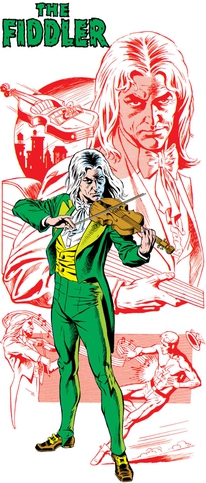Fictional character biography
The original Vigilante was a western-themed hero who debuted in Action Comics #42 (November 1941): originally named Greg Sanders, the spelling was changed to Greg Saunders in the 1990s. Grandson of a Native American fighter, and the son of a sheriff in Wyoming, Saunders, as a young man, moved east to New York City and became a country singer, radio's "Prairie Troubadour". Greg returned to his home after his father was killed, bringing to justice the gang of bandits who killed him. [2]
The Vigilante, like many heroes of the era, acquired a sidekick to aid him in his crime fighting. Stuff the Chinatown Kid was introduced in Action Comics #45. He assisted the Vigilante when a Japanese spy, known as the Head, framed Stuff's grandfather for provoking a Tong war.
The majority of the Vigilante's solo adventures were against non-powered, costumed criminals. He was an excellent brawler, trick shooter, sharpshooter, horseman/motorcycle rider, and an expert with the lariat. These skills gave him advantage over his adversaries in his adventures, which centered primarily in NYC.
The Vigilante fought few foes that could be considered real "super-villains". His arch-foes were the Dummy, a brilliant weapons inventor and professional killer who resembled a ventriloquist's dummy in both size and facial features, and the Rainbow Man, who committed crimes with a color motif. [3] The Vigilante also encountered the Rattler on several occasions, as well as the Fiddler and the Shade, though the latter two villains are not the same foes that battled the Flash. Other foes included Shakes the Underworld Poet and the Dictionary, a gangster with a heightened vocabulary. [4]
The Vigilante was also a member of the Seven Soldiers of Victory (also known as the Law's Legionnaires), one of the earliest super-hero teams (appearing in Leading Comics). In these adventures, his sidekick Stuff never appeared, being replaced by an old, somewhat crotchety man named Billy Gunn. The Vigilante was also one of the few super-hero features to survive the end of the "Golden Age" of super-hero comics, lasting as a solo feature until Action Comics #198 (1954), when he was permanently replaced by Tommy Tomorrow.
The Vigilante was revived during the "Bronze Age" in the pages of Justice League of America, when the Seven Soldiers of Victory were brought back into active continuity. Like Green Arrow, was a lost member of the Seven Soldiers, but he did not participate in the JLA/JSA quest to rescue them. All the members were hurled through time after defeating Nebula Man (except for Wing who was killed). The "Silver Age" Green Arrow, Black Canary and Johnny Thunder and Thunderbolt saved the Vigilante from a tribe of Native Americans in the Old West who felt that eventually the white men would take over their land. The Earth-1 Vigilante's contact with the League was limited to a two-part story where he aided the JLA against aliens determined to over-pollute the Earth. He remarks in his first appearance in Adventure Comics that the League did help him re-establish his career, even providing him with a new motorcycle. He later teams up with, and saves the life of Superman (his marksmanship allowed him to shoot a silver bullet at the shadow of a werewolf who, being a magical creature, was about to kill the Man of Steel). [5] He also received a periodic feature in the pages of Adventure Comics, drawn by both Mike Sekowsky and Gray Morrow, and also in World's Finest Comics.
The short-lived series in World's Finest culminated in the Vigilante coming to Gotham City to meet his old partner Stuff, only to find his friend murdered by his old enemy, the Dummy. At the end of this series, The Vigilante rode off with Stuff's son (who had been trained by Richard Dragon). [6]
Vigilante continued to sporadically appear as a superhero in DC Comics, having been established as running a dude ranch in Mesa City (the former home of Western hero Johnny Thunder).
Seven Soldiers
In Grant Morrison's Seven Soldiers #0, the Vigilante establishes a new Seven Soldiers of Victory to battle the monstrous spider of Miracle Mesa. He is apparently killed alongside the rest of the team, [7] only to re-appear as a ghost in Bulleteer #3 (also part of the Seven Soldiers series). He attempts to recruit a new team of seven to further battle the threat of the Sheeda. He claims Bulleteer's actions will allow him to 'rest'.
Return
In Superman's Pal Jimmy Olsen Greg Saunders appears, alive, as the sheriff of Warpath, a town on the Mexican border formerly known for supervillain activity. Olsen's narration notes that Saunders has been dead and came back to life but does not go into detail. Olsen also notes that Saunders appears younger, though he clearly retains all of his past experience. Saunders and a mysterious version of the hero known as the Guardian beat back a villainous invasion from Mexico. [8]
The New 52
In 2011, "The New 52" rebooted the DC Universe. Vigilante was renamed to Greg Sanders and operated in Opal City during the mid-20th Century. Shade contacted him to help rescue his great-grandson Darnell Caldecotte from Nazi spies. Once that was done, Shade upheld his deal with Vigilante by giving him the intel on the local gangs and they parted ways. [9]











